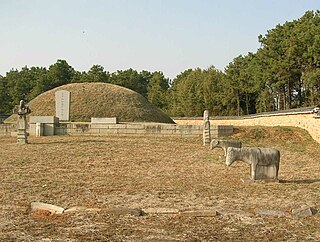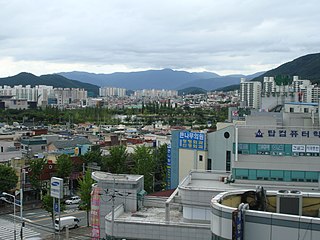
Pohang is a city in the province of North Gyeongsang, South Korea, and a main seaport in the Daegu-Gyeongbuk region. The built-up area of Pohang is located on the alluvium of the mouth of the Hyeongsan River. The city is divided into two wards (gu), Buk-gu or Northern Ward and Nam-gu or Southern Ward.

Cheongju is the capital and largest city of North Chungcheong Province in South Korea.

Damyang County (Damyang-gun) is a county in Jeollanam-do, South Korea. Tourism is a major local industry. Notable local products include bamboo goods and strawberries.

Hampyeong County (Hampyeong-gun) is a county in South Jeolla Province, South Korea.

Namwon is a city in North Jeolla Province, South Korea. Namwon is about 50 minutes from the provincial capital of Jeonju, which is almost three hours away from Seoul. The official city flower is Royal Azalea (철쭉) while the city tree is the crape-myrtle (배롱나무) and the city bird is the swallow (제비). Namwon is a small city located just outside Jirisan National Park, which has the largest set of mountains on the South Korean Mainland. It also borders the Seomjin River, one of South Korea's more prominent rivers. It is 3 hours and 15 minutes from the Seoul Central City Bus Terminal and about one hour from both the U-Square Bus Terminal in Gwangju and the Jeonju Inter City Bus Terminal. It is called "the City of Love" because of the famous Korean love story of Chunhyang. Gwanghallu Garden is a shrine to this love story.

Namyangju is a city in Gyeonggi Province, South Korea. To the east is Gapyeong County, to the west is Guri City, and to the north is Pocheon City.

Pocheon (Korean pronunciation: [pʰo.tɕʰʌn]) is a inland city in the far northeastern region of Gyeonggi province in South Korea. It covers 826.48 km (513.55 mi)2 with a population of 160,176 people, according to the 2008 census. Pocheon lies between Seoul and the mountainous northwestern areas of Gangwon province. The city borders Yeoncheon county, with the cities of Dongducheon and Yangju to the west, along with Uijeongbu, and Namyangju of Gyeonggi province to the south. It also borders Hwacheon county of Gangwon province on its eastern border and Cheorwon is to the north. Alongside the adjoining Gapyeong, Pocheon consists of the highest mountainous areas in Gyeonggi province. The current city of Pocheon was created after Pocheon-hyeon and Yeongpyeong counties were merged. The north part of the city used to be part of Yeongpyeong county while the south used to be part of Pocheon-hyeon.

Geumsan County (Geumsan-gun) is a county in South Chungcheong Province, South Korea.

Gimcheon is a city in North Gyeongsang Province, South Korea. It is situated on the major land transportation routes between Seoul and Busan, namely the Gyeongbu Expressway and Gyeongbu Line railway.

Sangju is a city in North Gyeongsang Province, South Korea. Although Sangju is rather rural, it is very old and was once a key city. Along with Gyeongju, it gives rise to half of the name of the Gyeongsang provinces. Sangju is nicknamed Sam Baek, or "Three Whites", referring to three prominent agricultural products rice, silkworm cocoons, and dried persimmons from the area.

Gimhae is a city in South Gyeongsang Province, South Korea. It is the seat of the large Gimhae Kim clan, one of the largest Kim clans in Korea. The Gimhae Kims claim descent from the ancient royal house of Geumgwan Gaya, which was based in Gimhae. Gimhae is situated near the Nakdong River.

Namhae County (Namhae-gun) is a county in South Gyeongsang Province, South Korea.

The Jogye Order, officially the Jogye Order of Korean Buddhism is the representative order of traditional Korean Buddhism with roots that date back 1,200 years to Unified Silla National Master Doui, who brought Seon and the practice taught by the Sixth Patriarch, Huineng, from China about 820 C.E. The name of the Order, Jogye, was adopted from the name of the village where Patriarch Huineng's home temple is located.

"North Pyeongan Province" or "Pyeonganbuk-do" is, according to South Korean law, a province of the Republic of Korea, as the South Korean government formally claims to be the legitimate government of the whole of Korea. The area constituting the province is under the de facto jurisdiction of North Korea.

"North Hamgyeong Province" or "Hamgyeongbuk-do" is, according to South Korean law, a province of the Republic of Korea, as the South Korean government formally claims to be the legitimate government of whole of Korea. The area constituting the province is under the de facto jurisdiction of North Korea.

"South Hamgyeong Province" or "Hamgyeongnam-do" is, according to South Korean law, a province of the Republic of Korea, as the South Korean government formally claims to be the legitimate government of whole of Korea. The area constituting the province is under the de facto jurisdiction of North Korea and China.
National Route 36 is a national highway in South Korea connects Boryeong to Sejong City, Cheongju, Chungju, and Uljin. It established on 31 August 1971.
National Route 43 is a national highway in South Korea connecting Sejong City to Kosong County. It was established on 31 August 1971.
National Route 32 is a national highway in South Korea connects Taean County to Jung District, Daejeon. It established on 31 August 1971.
Dangjin–Yeongdeok Expressway also known as 6th East–West Expressway is an expressway in South Korea connecting Dangjin to Yeongdeok County.


















